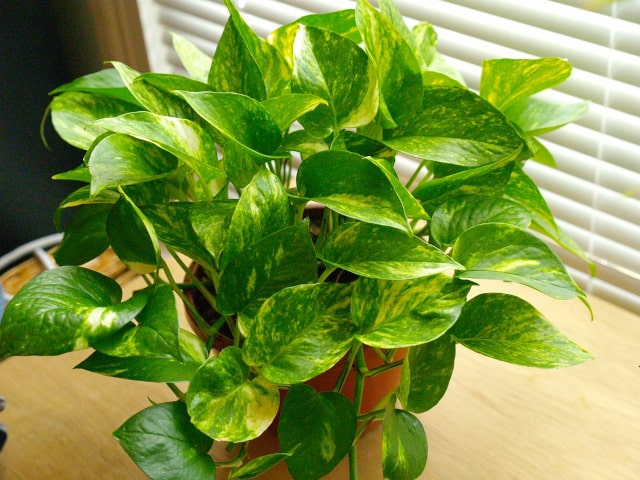
The Golden Pothos, Epipremnum aureum, is an amazing houseplant ideal for those without much experience. A great thing about this plant is that it can survive or even thrive under almost any condition. In fact, this plant can continue to grow and become even invasive in conditions that are generally bad for houseplants. Because of this, it got a nickname "Devils Ivy".
This plant is so hardy that it can survive even when there is no natural light. You can keep it in dark corners or in the shade. The Golden Photos can grow in fluorescent plant, which makes it a great choice for offices.
This plant can also survive an irregular watering schedule, so it is a good choice for those who travel a lot or those who forget about watering their plants regularly. The Golden Pothos can survive poor growing conditions.
Another great thing about this plant is its ability to purify the air. It can absorb and filter harmful chemicals from the air.
Epipremnum Aureum Plant Basics
The scientific name for the Golden Pothos is Epipremnum aureum. Keep in mind that the plant was known under other scientific names, so it is not always easy to identify this plant based on name alone. In North America, the often used name is Epipremnum pinnatum, while in Europe, it is known as Scindapsus aureus. This plant is also known as Phaphidophora aureu and Scindapsus aureau. Keep this in mind when buying Golden Pothos: some sellers still refer to the plant by other scientific names. The good news is that the plant is easy to recognize: it has trailing leaves and variegated foliage.
This plant is native to Mo'orea, a French Polynesian island. It has been naturalized all over the world, including Australia, China, Japan, India and the West Indies. It grows in tropical forests all around the world. It is not uncommon for the Golden Pothos to dominate any area. It can even cause ecological damage if it spreads too much. It had destroyed at least two rainforests in Sri Lanka. This plant has a strong invasive nature: it surrounds tree trunks and easily takes over floors of the rainforest. It can easily kill the neighboring plants. For this reason, the Golden Pothos is banned from being grown outdoors in certain US states.
There are several popular varieties of this plant you can grow in your home:
- Marble Queen. This is one of the most popular varieties of the Golden Pothos. It is famous for its white and green marbling effect on the foliage. Keep in mind that this variety requires more light than other Golden Pothos varieties, or else the leaves will turn all green and the marbling effect will be lost.
- Neon Pothos. This is a brightly colored variety that is very tolerant to different growing conditions. It has foliage in the lime green shade, with a glowing tint. You can plant this variety in a shady area, and it will grow without a problem. However, this plant prefers bright, indirect light.
- Satin Pothos. This variety is known for its grayish leaves that include silver markings. This variety is more tolerant of drought-like conditions and it can grow happily even in low lighting.
- Pearls and Jade Pothos. This is a variegated Pothos that is actually a mutation of the Marble Queen. It has gray-green leaves with white marbling effect around the edges of leaves.
If you wish to grow this plant in your home, there are only a few things to keep in mind:
Temperature Requirements
It is important to keep your Golden Pothos in temperatures that are suitable for this plant. It will thrive in temperatures between 60 and 85 degrees F (15-29 degrees Celsius). Keep in mind that this plant can generally withstand temperatures that are ten degrees hotter or colder than these, but it will not thrive. It means that your Golden Pothos will not be on its best health if temperatures are too hot or too cold.
To make your plant thrive, make sure to keep it away from cold draughts. Keep it away from open windows and doors during the winter months. Draughts can harm this plant so make sure your Golden Pothos is not subjected to it.
Light Requirements
A great thing about the Golden Pothos is that it can survive in basically any lighting conditions. It can even survive through total darkness for some period. However, it will thrive in a mix of moderate, indirect light and some shade. If you provide these ideal conditions, your Golden Pothos will be strong and healthy.
You may also grow your Golden Pothos in shaded spots or areas with low-quality light. It can also grow under fluorescent light, which makes it a perfect plant for offices. However, keep in mind that your plant will not grow as much under these conditions.
In case your Golden Pothos is of a variegated variety, keep in mind that the colored pattern on leaves might fade or disappear completely under low light. Once you put your plant back into a well-light environment, the variegation will typically return, although it is not guaranteed.
In case you keep your Golden Pothos in a spot with too bright light, it will survive but it might develop burns. However, these are not ideal conditions for Golden Pothos plants. If you wish to keep it on a windowsill that gets full sun, make sure to use window drapes of blinds. This will give your plant a more tolerable level of light. Also, keep in mind that colors on the foliage can fade under too bright lighting conditions.
Water Requirements
The Golden Pothos prefers if the soil gets completely dry between waterings. If the soil is constantly moist, it can develop a root rot, which can damage the plant. Before watering, you should check the soil by dipping a finger into the top layer. If it feels dry to the touch, proceed to water the plant. However, if it feels moist, it is a sign to wait for a few days before checking again.
Some people even choose to wait until the plant starts dropping its leaves. It is a sure sign that the plant is thirsty and that you need to water it. After watering, the Golden Pothos will stop dropping leaves and will spring back to life within a day or two. This is a good strategy if you are otherwise unsure when to water you Golden Pothos. However, make sure that the leaves only drop a little: you should never wait until the leaves are so dry, they begin to shrivel, brown and fall off the plant. This can be very damaging even for an otherwise sturdy plant like the Golden Pothos. Also, in case the soil is dry all the time, the leaves will likely turn rubbery in texture.
So, how much water is appropriate? Generally speaking, a good watering once per week is enough for this plant. However, this may depend on the size of the plant and other conditions. For example, during the winter, the plant will need less water than usual. It will benefit from misting during this time. Use a water spray bottle to lightly mist your Golden Pothos during winter.
Keep in mind that overwatering is always a bigger issue than underwatering for this plant. The Golden Pothos can generally tolerate dry conditions for relatively extended period of time. The plant will not die, but keep in mind that it will suffer, and its growth will likely be affected. The good news is that you can probably bring the plant to the optimal condition if you start to water properly.
With the Golden Pothos, going on a vacation is typically not a problem. Simply water it before you go and water it again when you come back. This is why Golden Pothos is an ideal plant for those with a busy lifestyle.
Humidity Requirements
The Golden Pothos will thrive in typical humidity levels found in most homes during the summer months. However, it will benefit from some light misting during the winter months. This is particularly important if your indoors air is too dry during the winter months.
To increase humidity around your Golden Pothos during the winter months, place the plant's pot on a tray of pebbles surrounded by water. The evaporating water will increase humidity around your plant.
Repotting
A great thing about the Golden Pothos is that it is easy to tell when it needs repotting. The clear sign are aerial roots. The plant will shoot these roots out in search of new soil. It might even break free from its container. Another way to know is through falling leaves. If you notice your Golden Pothos shedding its leaves despite having proper water and light conditions, it is a sign the current pot is getting too small. All of these are clear signs that it is time to repot your plant to a larger container.
To repot your Golden Pothos, place it in a container that is one or two sizes bigger. Use good potting soil that is well-draining. You can improve draining by filling the bottom of the container with pebbles.
Pruning
Keep in mind that the Golden Pothos is a trailing vine that has a vigorous growth. It means it will easily become too big and messy unless you prune it. Pruning is not too difficult, especially if you know what you wish to achieve.
For example, if the plant is getting too leggy, you should prune stems back to the tips. This will allow the plant to grow in a new way and achieve a fuller appearance.
In the case your Golden Pothos becomes too long, you should simply cut back the length. Do this as soon as you notice vines becoming too long. You can also weave the vines around your furniture. Stair banisters and curtain poles are a good choice. This will give your Golden Pothos a climbing plant appearance. Keep in mind that Golden Pothos is not a climber, so this is a quick way to achieve this effect.
The Golden Pothos is a trailer, so it looks great as a hanging plant. You can place it on a tall shelf to have stems hanging from a pot. However, these vines can become messy and tangled, so you need to keep them separated. The best way to do this is by simply shaking out the pot occasionally.
Propagation
Propagating Golden Pothos is very easy, and it has high success rate. It means that even beginner gardeners can try propagating these plants. To propagate your Golden Pothos, take a stem cutting from the tip. Place it into the soil. It will gradually grow its own roots and develop into a new plant. Alternatively, you can grow cuttings without soil: grow it in the water and it will produce the same result. It is very easy to propagate your Golden Pothos from cuttings.
Another way to go is to propagate through division. In this method, you will take a Golden Pothos plant and divide it in half during repotting. You can simply tear the plant down the middle. Make sure to separate the roots. You can simply repot each part into a separate container to get two Golden Pothos plants. They will continue to develop int their individual pots.
Toxicity
It is very important to know that all parts of Golden Pothos are toxic to humans. The same goes for cats and dogs: this plant is toxic for your pets. The plant contains calcium oxalates, which are poisonous if ingested. This is why it's best not to grow the Golden Pothos in your home if you have pets or small children. You may keep your Golden Pothos high on the shelves and out of the reach of children and dogs, but keep in mind that cats will generally be able to reach even the highest places in the home.
If ingested, Golden Pothos will cause strong irritation of the mouth, lips and tongue, along with a burning sensation. Vomiting and stomach upset are common signs of poisoning. For pets, watch for excessive drooling and pawing of the mouth. In rarer cases, ingestion can cause swelling of the airways and difficulty breathing.
Poisoning with Golden Pothos is typically mild to moderate, but this plant is known to kill a pet. You should always consult a vet if you suspect that your pet has ingested Golden Pothos. For humans, call doctor immediately if you suspect a child or another member of your household has ingested Golden Pothos.
Common Problems with Golden Pothos
Here are some of the most common diseases and issues you can have with your Golden Pothos:
- Rotting Stems. This is a problem caused either by over-watering or sudden cold temperatures. You will know temperature is to blame is the plant's leaves droop down. Cut the rotting stems and move your plant to a warmer spot to let it recover. However, if the cause is overwatering, make sure to check for root rot. Remove any rotten stems, even if it means cutting the plant back. If there is root rot, repot the plant and follow a better watering regime in the future.
- Falling Yellow Leaves. This is a problem likely caused by overwatering. Make sure to adopt a better watering regime to prevent this from happening.
- Brown Tips. Sometimes, the tips of the leaves may become brown. This is typically due to humidity and dry air. You can correct this problem by increasing the humidity around your Golden Pothos. Simply mist the plant with a water spray every other day and the symptoms should resolve shortly.
- Loss of Variegation. If you notice previously variegated leaves becoming solid green, it means that your Golden Pothos needs more light. On the other hand, if leaves turn pale and the pattern fades, it is typically because of strong light. You can solve both of these problems by moving your Golden Pothos to a better spot where it can get appropriate amount of sunlight.
Photo credit: Elvis Ripley
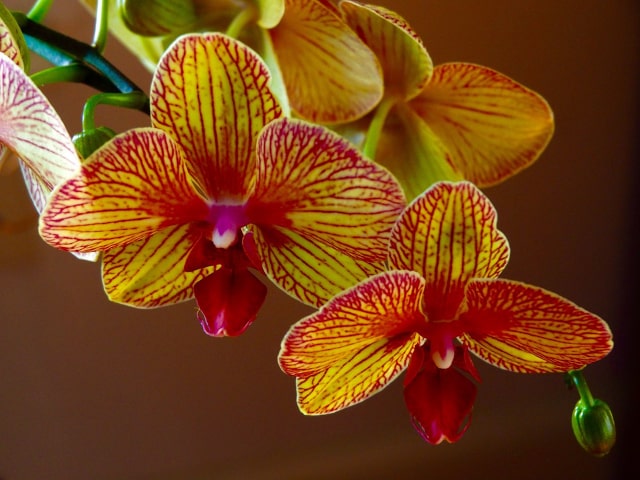
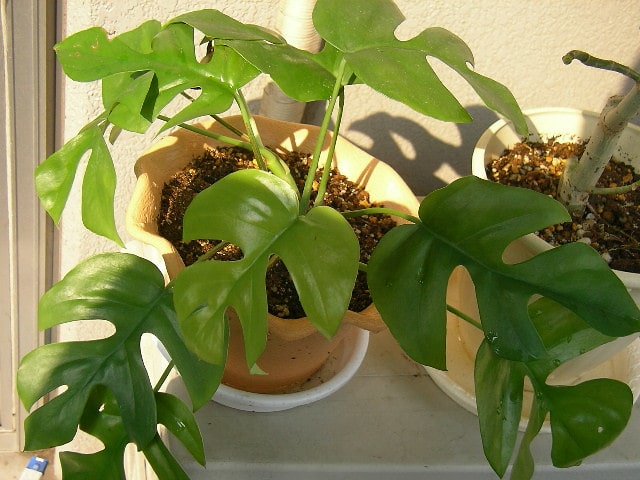
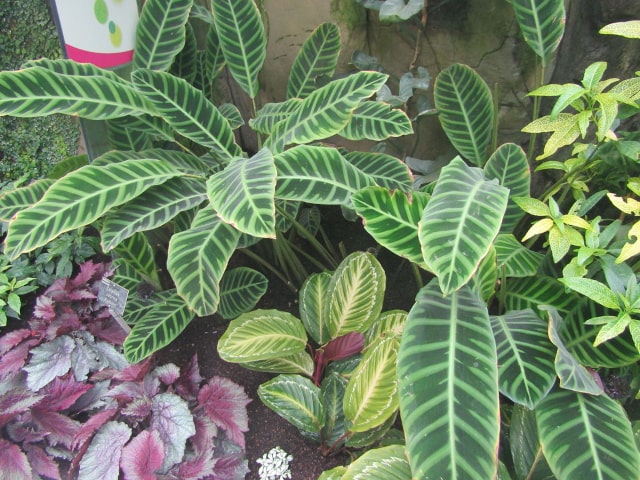
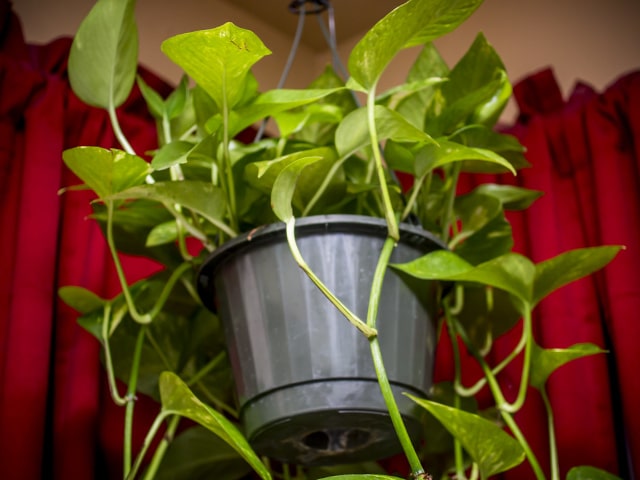
0 Comments